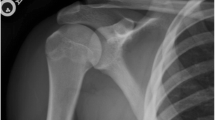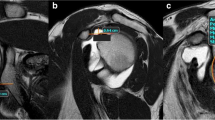Abstract
Primary traumatic anterior dislocation of the shoulder in young patients has a high recurrency rate. There are varying opinions on the pathology behind the recurrences. The aim of this study was to describe the MRI characteristics of the acute lesion, and at 6-month follow-up. Thirty patients aged 18–30 years with primary traumatic anterior dislocation of the shoulder were randomized into two groups. One group was treated with acute arthroscopic lavage within 10 days. The control group was treated with traditional non-operative therapy. All patients underwent acute MRI within 10 days and before the arthroscopic lavage, and again at the 6-month follow-up, for evaluation of the lesions. The acute MRI verified Hill-Sachs lesions in all patients. At the 6-month follow-up MRI, there was no change in the size of the Hill-Sachs lesion. This was also the case with the six patients in the control group with recurrent dislocations during the first 6 months. Twenty-nine patients (97%) had joint effusion at the acute MRI, which was very useful for evaluation of the soft tissue pathology. The glenohumeral ligaments were detached in 20/30 patients (66%), and the labrum in 22/30 patients (70%). A capsulolabral detachment classified as a Baker 3 lesion was seen in 16/30 (53%) of the patients, including all six patients with recurrent dislocation. At the 6-month control, only 3/30 (10%) of the patients had joint effusion for adequate evaluation of the labrum and ligamentous pathology. A Hill-Sachs lesion was found in 100% of the patients after primary dislocation, and recurrent dislocations did not change the size of the lesion. The study supports the opinion that this lesion is overlooked in the clinical situation. The joint effusion at the acute MRI was of utmost importance for evaluation of the soft tissue pathology. The 6-month MRI control was therefore considered inconclusive when evaluating capsulolabral lesions, due to lack of effusion. MRI arthrography with contrast administration would have been very helpful at the 6-month examination.
Similar content being viewed by others
References
Akad AME, Winge S, Eriksson E (1993) Arthroscopic Bankart procedures for anterior shoulder instability. Knee Surg Sports Traumatol Arthroscopy 1:113–122
Baker CL, Uribe JW, Whitman C (1990) Arthroscopic evaluation of acute initial anterior shoulder dislocations. Am J Sports Med 18:25–28
Bankart ASB (1938) The pathology and treatment of recurrent dislocation of the shoulder joint. Br J Surg 26: 23–29
Calhandra JJ, Baker CL, Uribe J (1989) The incidence of Hill-Sachs lesion in initial anterior shoulder dislocations. Arthroscopy 5:254–257
Cartland JP, Crues JV III, Stauffer A, Nottage W, Ryu RKN (1992) MR imaging in the evaluation of SLAP injuries of the shoulder: findings in 10 patients. AJR 159: 787–792
Crues JV III, Ryu R (1991) The shoulder. In: Stark D, Bradley YC (eds) Magnetic resonance imaging. Mosby, St. Louis, pp 2424–2458
De Anquin CE (1965) Recurrent dislocation of the shoulder. Roentgenographic study. J Bone Joint Surg [Am] 47:1085
Engebrektsen L, Craig V (1993) Radiologic features of shoulder instability. Clin Orthop Relat Res 291:29–44
Fritts HM, Craig EV (1994) MRI of the shoulder. Semin Ultrasound CT MRI, 15:341–365
Habermeyer P, Kreuger P, Schweiberer L (1988) Verletzungen der Schulterregion. Springer, Berlin Heidelberg New York
Hermodsen I (1934) Röntgenologischen Studien über die traumatischen und habituellen Schultergelenkverrenkungen nach vorn und nach unten. Acta Radiol [Suppl] 20:1–173
Hertz H, Kwasny O, Wohry G (1991) Therapeutic procedure in initial traumatic shoulder dislocation. Unfallchirurgie 17:76–79
Hill HA, Sachs MD (1940) The groove defect of the humeral head. A frequently unrecognized complication of dislocations of the shoulder joint. Radiology 35:690–700
Hovelius L (1987) Anterior dislocation of the shoulder in teenagers and young adults. Five year prognosis. J Bone Joint Surg [Am] 69:393–399
Jerosch J von, Castro WHM, Assheuer J (1992) MR diagnostics of glenoid labrum changes in patients with unstable shoulder joints. Sportverl Sportschad 6:106–112
Kreitner KF von, Grebe P, Runkel M, Oberbillig C, Just M (1992) MR imaging in the evaluation of acute shoulder dislocations. Fortschr Röntgenstr 157: 229–234
Norlin R (1993) Intraarticular pathology in acute, first-time anterior shoulder dislocation: an arthroscopic study. Arthroscopy 9:546–549
Palmer WP, Caslowitz PL (1995) Anterior shoulder instability: diagnostic criteria determined from prospective analysis of 121 MR arthrograms. Radiology 197:819–825
Rowe CR (1956) Prognosis of dislocations of the shoulder. J Bone Joint Surg [Am] 38:957–977
Rowe CR (1980) Acute and recurrent anterior dislocation of the shoulder. Orthop Clin North Am 11:253–270
Runkel M, Kreitner KF, Wenda K, Rudig L, Degreif J, Grebe P (1993) MRI in shoulder dislocation. Unfallchirurg 96:124–128
Seeger LL, Gold RH, Bassett LW (1988) Shoulder instability: evaluation with MR imaging. Radiology 168: 695–697
Sievers KW, Riediger H, Oliver LC, Dresing K (1995) Shoulder injury diagnosed by computed and magnetic resonance tomography. Unfallchirurg 98:1–5
Simonet WT, Cofield RH (1984) Prognosis in anterior shoulder dislocation. Am J Sports Med 12:19–24
Snyder SJ, Kartzel RP, Del Pizzo W (1990) SLAP lesions of the shoulder. Arthroscopy 6:274
Tirman PFJ, Stauffer AE, Crues JV III, Turner RM, Nottage WM, Schobert WE, Rubin BD, Janzen DL, Linares RC (1993) Saline magnetic resonance arthrography in the evaluation of glenohumeral instability. Arthroscopy 9:550–559
Wintzell G, Haglund-Åkerlind Y, Tidermark J, Wredmark T, Eriksson E (1996) Arthroscopic lavage in acute primary anterior dislocation of the shoulder. A prospective controlled randomized study. One year follow up. Knee Surg Sports Traumatol Arthroscopy 4:43–47
Workman TL, Burkhard TK, Resnick D, Goff WB II, Balsara ZN, Davis DJ, Lapoint JM (1992) Hill-Sachs lesion: comparison of detection with MR imaging, radiography, and arthroscopy. Radiology 185:847–852
Author information
Authors and Affiliations
Rights and permissions
About this article
Cite this article
Wintzell, G., Haglund-Åkerlind, Y., Tengvar, M. et al. MRI examination of the glenohumeral joint after traumatic primary anterior dislocation. Knee Surg, Sports traumatol, Arthroscopy 4, 232–236 (1996). https://doi.org/10.1007/BF01567969
Received:
Accepted:
Issue Date:
DOI: https://doi.org/10.1007/BF01567969




